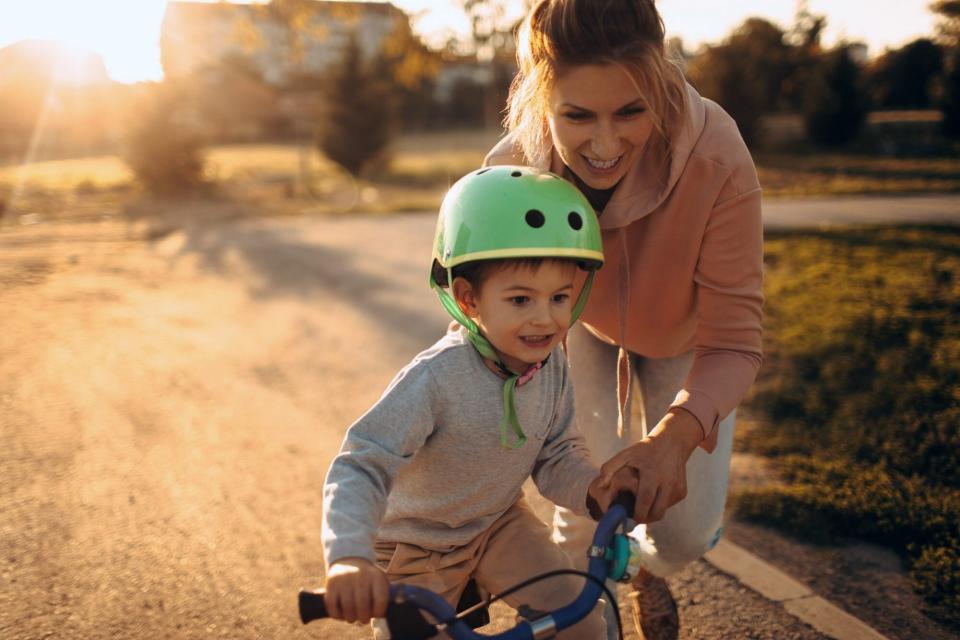How to Teach a Kid to Ride a Bike
Riding a bike represents fun, freedom, and fresh air—everything that's good about being a kid. But before your child embarks on neighborhood cruises with friends, they should learn to ride a bike without the training wheels. They're typically ready for this milestone around age 5 or 6, says Susan McLucas, founder of the Bicycle Riding School, in Somerville, Massachusetts. (As with any activity, though, kids' readiness can vary).
Are you wondering how to teach riding a bike to a child? Follow these expert-approved tips to ease the transition to big-kid biking.
Zero in on physical ability.
Even if your child asks to take their training wheels off, it's important to assess whether they can manage a two-wheeler. Watch how they perform other "non-bicycle" activities, such as skating, skiing, gymnastics, skateboarding, or scooter-riding to get a good sense of their balance and core strength, says Steven Finkelstein, founder of Professor Pedals, a riding school in Syosset, New York. Your child must also be mature enough to understand the rules of traffic. If they can't cross the street on their own yet, make sure they know to stay on the sidewalk or in a park while riding a bike.

Getty Images.
Scope out a good practice space.
Once you unscrew those pesky training wheels, find a quiet open area to teach your child how to ride a bike. "Kids need to have room to swerve and get their balance," McLucas says. "The bike will tell him where to go at first and he'll need to turn the way it leans." If you're nervous about having your child ride on pavement, look for a park with a gentle, grassy slope away from parked cars, playground equipment, and rough bushes that may block their path. Here, your child can get a feel for how the bike moves and learn how to steer.
Build one skill at a time.
You may need to lower the seat for your initial practice sessions. Your child should be able to place their feet flat on the ground when they're sitting on the bike's seat. Show them how to get on and off the bike by standing on the side and then swinging their leg over the back wheel. Then make sure they can locate and use the brakes. When they're ready to try riding, have them "scoot" on flat ground to practice balance.
"While she's seated on the bicycle, have your child walk it and try to raise both feet off the ground for a few seconds, slowly increasing the duration," Finkelstein says. "When she's ready, incorporate pedaling into the process."
Stay by their side and put one hand on their upper back and the other on their arm to help them steer. (Resist holding the back of the bike seat—it can hamper your child's balance and even injure you in the process.) As they develop balance and control, loosen your grip on their seat but stay close in case they need your help again.
Know when to call it quits.
Keep your child's initial learning session to a manageable length—no more than 60 minutes, experts say. At the first sign of fatigue (flagging energy, whining, maybe a few tears) take a break for the day. Instead of ending the lesson when your kid is crying and you're screaming, call it quits after a positive moment, such as a longer "scoot" without falling over.
If your child has a frustrating day but still seems ready to learn, try again tomorrow or the next day. "If he doesn't make progress toward being able to control the bike on his own within three sessions, take a break for a couple of weeks or even a month and then come back to it," suggests Finkelstein. Some kids have the necessary coordination and balance earlier than others.
In the meantime, encourage your little one to focus on other ways to improve their balance like riding a scooter or swinging. Pay attention to any cues that they may want to try learning again. If they're talking about their bike or mentioning that their friends are riding, they may be ready to give it another go.

